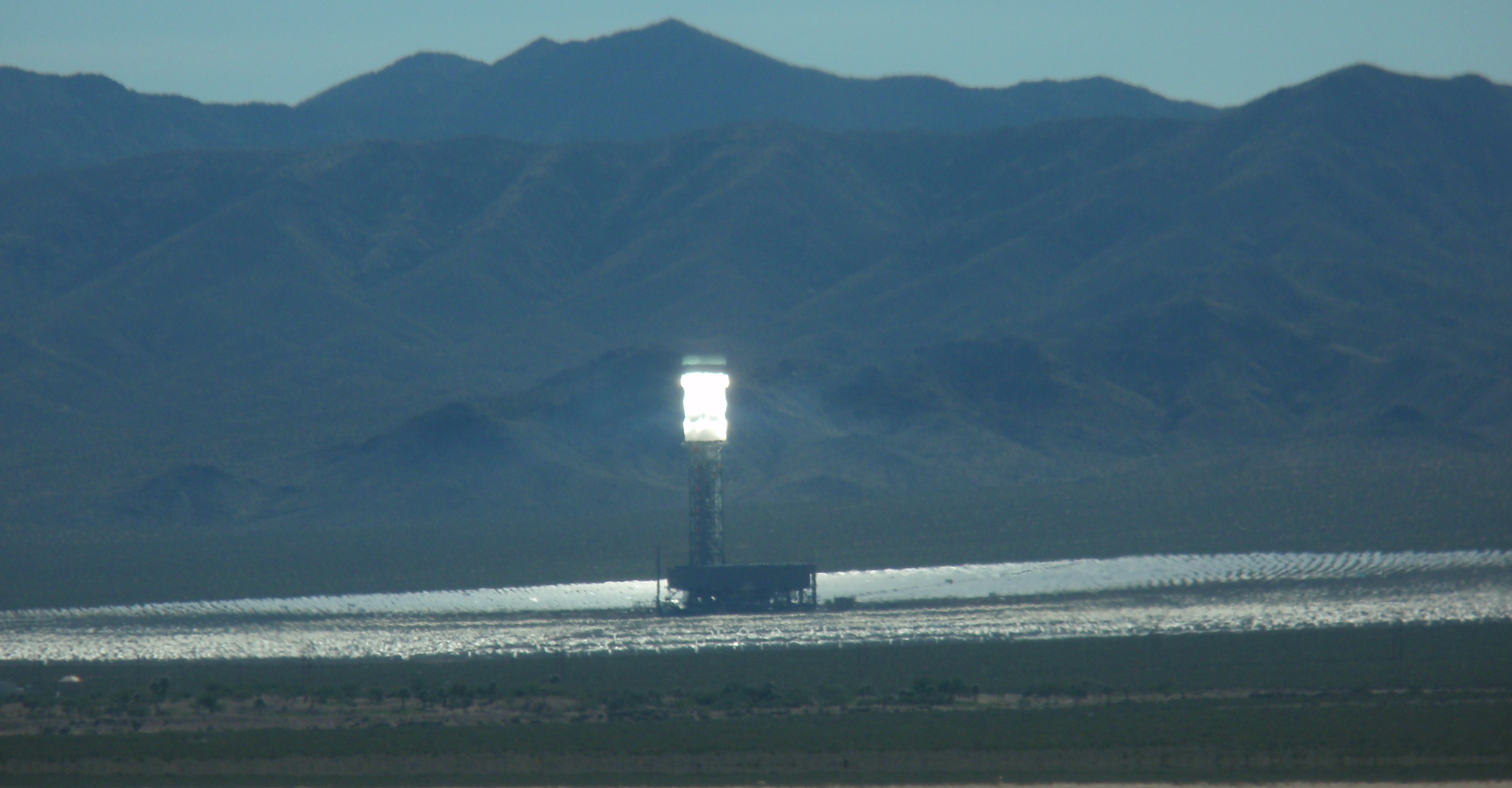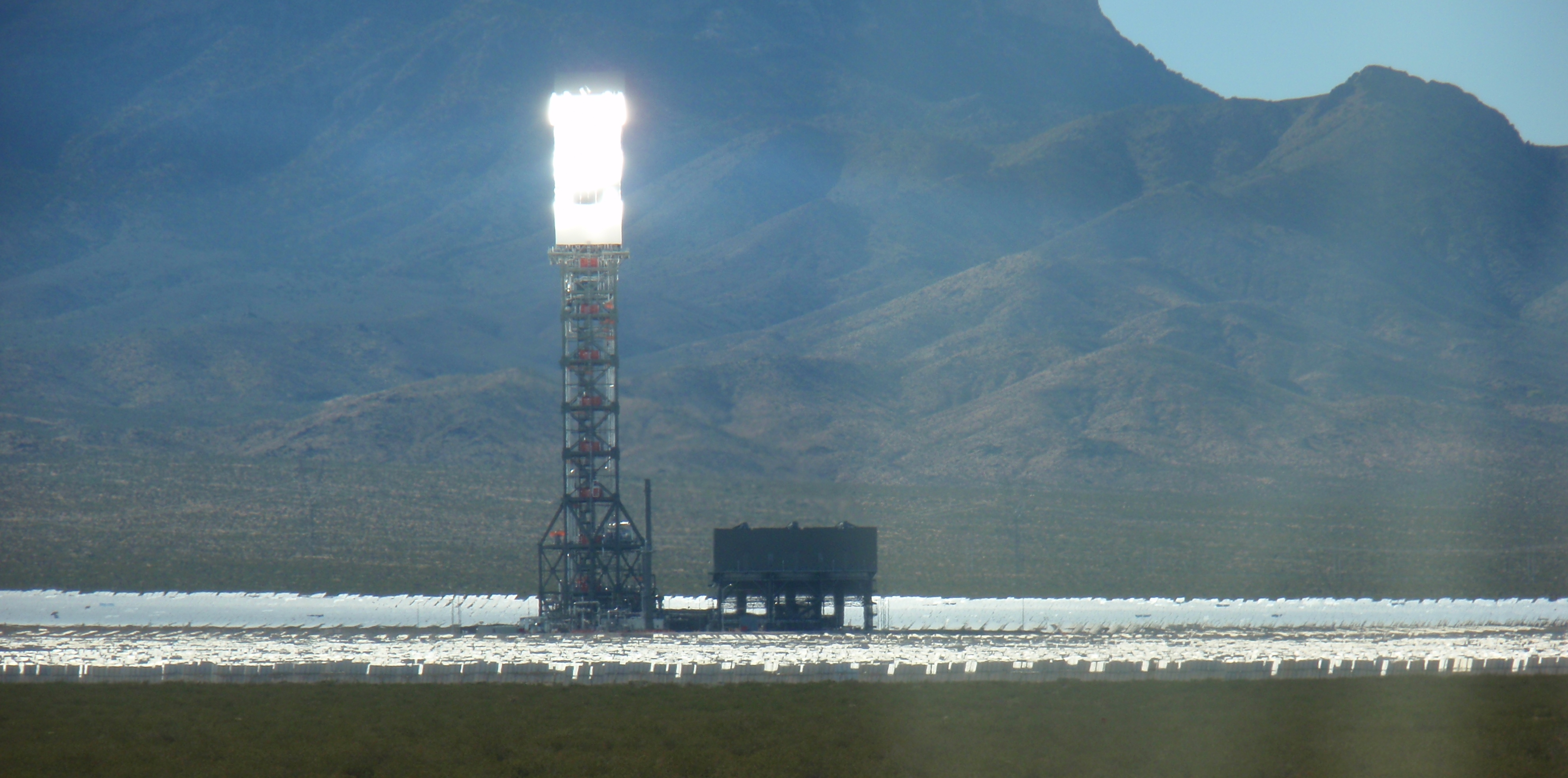The Ivanpah Solar Electric Generating System is a huge solar farm in California near the Nevada border. It is quite visible just north of I-15 a few miles south of the border. An article at the Washington Post by Lenny Bernstein provides a lot of background on the solar farm: Solar on a grand scale: Big power plants coming online in the West.
All photos in this post are of the Ivanpah solar farm and were taken by me in October 2013. Photo above shows one tower in operation and the lake-like mirrors around it.
Since I expect to be writing about Ivanpah and other thermal solar facilities in the future, here’s some of the general background from the 1,500 word article.
Operational description
Mirrors reflect sunlight to one of three towers, which heats the tower to 1,000 degrees. The tower glows white-hot when in operation. From my personal observation and pictures of the towers, there is a horizontal plane of visible white light surrounding the towers. The heat reflected to the tower vaporizes water into steam, which drives turbines, which generates electricity.
The article says the towers are as high as a 46 story building. The panels cover 3,500 acres. At 640 acres to the mile, that is about 5.5 square miles.
There are 173,500 sets of mirrors that are computer controlled to keep the light reflected on the towers according to the article. Every few months a robot cleans the mirrors.
(above photo shows all three towers; only one is in operation)
Boom times for solar industry
There are 232 solar farms under construction in the U.S., according to the article. The Ivanpah farm is reported to cost $2.5 billion.
Driving the solar farm boom is a requirement from states to hit certain targets of renewable sources of electricity. California for example requires 20% of our electricity be from solar and wind by 2010 and 33% by 2020, according to the article.
Enabling the boom are huge tax credits that run through 2016. The Ivanpah farm also got a $1.6 billion loan guarantee.
Solar output barely measurable
Check out the inconsequential portion of electricity we get from solar:
In 2012, coal and natural gas plants produced 37 percent and 30 percent of U.S. electricity, respectively, according to the U.S. Energy Information Administration, while wind generated 3.5 percent and solar just 0.1 percent.
Here’s that data again:
- 37.0% – coal
- 30.0% – natural gas
- 3.5% – wind-powered slice-and-dicers
- 0.1% – solar-powered wing-toasters
Ivanpah is a thermal farm, also called a concentrating solar power plant. The other main technology uses photovoltaic cells to directly convert sunlight to energy. Those are the flat panels you see on people’s roofs.
Environmental damage
The environmental risks are starting to get attention. Another thermal farm planned by the owner of Ivahpah was put on hold by the state regulators…
…because of its concerns that super-heated plumes of air from the towers and mirrors might harm birds. A small number of singed dead birds have turned up at Ivanpah, according to media reports.
Focus of the article obviously isn’t on the death count of birds, but notice the vague background? There are a few reports. Cause of death unknown. Possible harm from the concentrated heat. Uncertainty of the exact threat vector.
The article goes into detail on a split amongst environmental groups. Some oppose the massive solar farms and some are sitting out this fight.
Initial concerns were there were only a few desert tortoises on the site. Lots more have been found. The plant owner has several mitigation projects underway, including building a fence around the site, running 7,000 acres of alternative habitat, and raising a large brood of tortoises that will be released into the wild when mature.
One environmentalist’s dismissive response:
“That’s like arguing it’s okay to pave the desert over because we can move all the animals to a zoo.”
More on the tortoises in a later post.
As for the damage to migratory birds, there are only those brief comments in the article that there may be some sort of unknown, minimal damage involved.
(closeup of one tower – that white glare to each side of the tower is not just a camera illusion – there really is a white-hot haze next to the 1,000 degree collection point that is visible to the naked eye)
Water usage
The steam is cooled and reused. The result is water used by the Ivanpah plant annually is the same as two holes of a neighboring golf course.
I’ve discussed large-scale water usage before: Tradeoffs in using water – keep 57 golf courses green for a year or produce 2 billion barrels of oil
The tradeoff I calculated in that post is the water needed to irrigate 57 golf courses in Palm Springs for a year is equal to the water needed to drill 4,161 wells in North Dakota. That’s a ratio of 73 wells to 1 golf course, or 4.1 wells for one hole.
That means the Ivanpah wing toaster uses enough water in a year to drill 8 wells in North Dakota.
Eight wells at 500,000 barrels of estimated ultimate recovery are equal to around 4,000,000 barrels of oil. The tradeoff in water? Ivahpah for one year or 4M barrels of oil.


